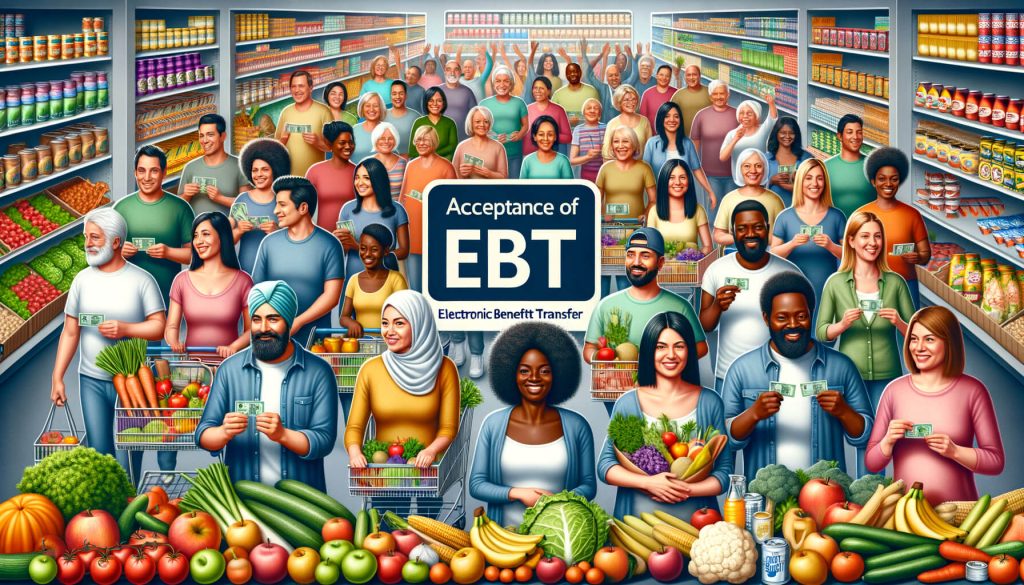
By Ethan Brooks November 1, 2024
Understanding EBT payments is crucial for retailers looking to expand their customer base and increase revenue. The Electronic Benefits Transfer (EBT) system is a government initiative that allows recipients of food assistance programs, such as the Supplemental Nutrition Assistance Program (SNAP), to purchase eligible food items using a specialized debit card. By accepting EBT payments, stores can tap into a significant segment of the population that relies on these benefits for their grocery needs. This not only broadens the customer base but also enhances the store’s reputation as an inclusive and community-oriented business.
To begin with, accepting EBT payments can significantly increase a store’s customer base. Millions of Americans rely on SNAP benefits to meet their nutritional needs, and by accommodating these customers, stores can attract a steady stream of shoppers who might otherwise go elsewhere. This is particularly important in areas with high rates of food insecurity, where SNAP recipients form a substantial portion of the local population. By offering EBT payment options, stores can position themselves as accessible and supportive of community needs, thereby fostering customer loyalty and repeat business.
Moreover, the ability to accept EBT payments can lead to increased revenue. When stores open their doors to EBT cardholders, they are not only serving a larger customer base but also encouraging higher sales volumes. SNAP benefits are typically distributed monthly, and recipients often plan their shopping around these disbursements. This can result in predictable spikes in sales, providing a reliable revenue stream for retailers. Additionally, EBT transactions can lead to increased sales of non-EBT eligible items, as customers often purchase additional goods that are not covered by their benefits, thereby boosting overall sales figures.
Furthermore, accepting EBT payments can enhance a store’s community image. In today’s socially conscious market, consumers are increasingly drawn to businesses that demonstrate a commitment to social responsibility and inclusivity. By accepting EBT, stores send a powerful message that they care about the well-being of all community members, including those who are economically disadvantaged. This can improve the store’s reputation and attract a broader demographic of customers who value businesses that prioritize social good.
In addition to these benefits, the process of setting up EBT payments is relatively straightforward. Retailers need to apply for authorization through the United States Department of Agriculture (USDA) and ensure their point-of-sale systems are equipped to handle EBT transactions. While there may be initial setup costs, the long-term benefits of increased customer traffic and sales often outweigh these expenses. Moreover, many states offer support and resources to help retailers navigate the process, making it easier for businesses to get started.
How Accepting EBT Payments Can Expand Your Customer Base

Accepting EBT payments can significantly expand your customer base by attracting individuals who rely on government assistance programs. According to the United States Department of Agriculture (USDA), over 42 million Americans participate in the Supplemental Nutrition Assistance Program (SNAP), which utilizes EBT payments. By accepting EBT, you tap into this vast market, increasing foot traffic and potential sales.
- Increased Foot Traffic: By accepting EBT payments, you become an accessible and inclusive store for individuals who rely on government assistance. This can lead to increased foot traffic as these customers are more likely to choose your store over competitors that do not accept EBT.
- Enhanced Reputation: Accepting EBT payments demonstrates your commitment to serving the community and supporting those in need. This can enhance your store’s reputation and attract customers who value businesses that prioritize social responsibility.
- Word-of-Mouth Marketing: Satisfied EBT customers are likely to spread the word about your store’s acceptance of EBT payments, attracting more individuals who rely on government assistance and expanding your customer base organically.
Boosting Sales and Revenue by Accepting EBT Payments

Accepting EBT payments can have a direct impact on your store’s sales and revenue. By catering to a wider customer base, you can tap into new revenue streams and increase overall profitability.
- Increased Sales Volume: EBT payments allow customers to purchase essential items, such as groceries, which are often recurring purchases. By accepting EBT, you can capture a portion of these customers’ spending, leading to increased sales volume.
- Higher Average Transaction Value: EBT customers tend to purchase larger quantities of items due to their limited financial resources. By accepting EBT payments, you can benefit from higher average transaction values, boosting your store’s revenue.
- Repeat Business: EBT customers often have consistent purchasing patterns, making them valuable repeat customers. By providing a positive shopping experience and accepting EBT payments, you can foster customer loyalty and encourage repeat business.
The Convenience and Accessibility of EBT Payments for Customers
EBT payments offer convenience and accessibility to customers, making it an attractive payment option for many. By accepting EBT, you can cater to the needs of a diverse customer base and provide a seamless shopping experience.
- Ease of Use: EBT payments function similarly to debit cards, allowing customers to make purchases effortlessly. By accepting EBT, you eliminate the need for customers to carry cash or rely on alternative payment methods, enhancing convenience.
- Increased Shopping Options: By accepting EBT payments, you provide customers with more shopping options. This allows them to choose the store that best suits their needs, fostering competition and driving innovation in the market.
- Empowering Customers: Accepting EBT payments empowers customers by giving them the freedom to choose where they shop. By offering this payment option, you contribute to their sense of dignity and independence.
The Process of Accepting EBT Payments in Your Store
Accepting EBT payments in your store involves a straightforward process that can be easily implemented. Understanding the steps involved will help you seamlessly integrate EBT payments into your existing payment infrastructure.
- Obtain a SNAP Retailer ID: To accept EBT payments, you must first obtain a SNAP Retailer ID from the USDA. This ID is necessary to participate in the SNAP program and process EBT transactions.
- Choose an EBT Processor: Select an EBT processor that suits your store’s needs. Consider factors such as transaction fees, customer support, and compatibility with your existing point-of-sale system.
- Upgrade Your Point-of-Sale System: Ensure that your point-of-sale system is compatible with EBT payments. If necessary, upgrade your system to accommodate EBT transactions.
- Train Staff: Provide comprehensive training to your staff on how to process EBT payments. This will ensure a smooth customer experience and minimize errors during transactions.
- Display EBT Acceptance Signage: Clearly display signage indicating that your store accepts EBT payments. This will inform customers and attract EBT users to your store.
Ensuring Compliance and Security When Accepting EBT Payments
When accepting EBT payments, it is crucial to prioritize compliance and security to protect both your store and your customers. Adhering to regulations and implementing robust security measures will build trust and safeguard sensitive information.
- Compliance with SNAP Regulations: Familiarize yourself with the SNAP regulations and ensure that your store complies with all requirements. This includes maintaining accurate records, adhering to eligible item restrictions, and participating in periodic audits.
- Secure Payment Processing: Implement secure payment processing systems to protect customer data and prevent fraud. This includes using encryption technology, regularly updating software, and adhering to Payment Card Industry Data Security Standard (PCI DSS) guidelines.
- Staff Training on Security Protocols: Train your staff on security protocols to prevent unauthorized access to customer information. This includes educating them on the importance of password protection, secure network connections, and recognizing potential security threats.
Enhancing Community Support and Loyalty Through EBT Acceptance

Accepting Electronic Benefit Transfer (EBT) payments in your store can significantly enhance community support and foster customer loyalty. By embracing this payment method, businesses not only expand their customer base but also contribute positively to the local community. EBT acceptance allows stores to cater to a diverse clientele, including low-income families who rely on government assistance programs such as the Supplemental Nutrition Assistance Program (SNAP). This inclusivity can lead to increased foot traffic and sales, as more customers are able to shop at your store using their benefits.
Moreover, accepting EBT payments demonstrates a store’s commitment to social responsibility. It shows that the business is attuned to the needs of the community and is willing to support those who may be facing financial challenges. This can enhance the store’s reputation and build goodwill among customers, who are likely to appreciate and support businesses that prioritize community welfare. In turn, this can lead to stronger customer loyalty, as shoppers are more inclined to return to a store that aligns with their values and supports their community.
Furthermore, EBT acceptance can help bridge the gap between different socioeconomic groups within the community. By providing access to a wider range of products and services, stores can help ensure that all community members have the opportunity to purchase nutritious food and essential items. This can contribute to improved public health outcomes and a more equitable society, as individuals from all backgrounds are able to access the resources they need to thrive.
In addition to these social benefits, accepting EBT payments can also offer financial advantages for businesses. By tapping into the EBT market, stores can increase their revenue and gain a competitive edge over businesses that do not accept this form of payment. This can be particularly beneficial for small and medium-sized enterprises, which may struggle to compete with larger retailers. By offering EBT as a payment option, these businesses can attract a loyal customer base and boost their bottom line.
To successfully implement EBT acceptance, stores should ensure that their staff is well-trained in handling these transactions. This includes understanding the specific regulations and requirements associated with EBT payments, as well as providing excellent customer service to EBT cardholders. By doing so, businesses can create a seamless shopping experience for all customers, further enhancing their reputation and fostering loyalty.
Streamlining Operations and Compliance: The Practicalities of Implementing EBT Systems

Implementing Electronic Benefit Transfer (EBT) systems in retail stores is a strategic move that can streamline operations and ensure compliance with federal regulations. As more consumers rely on government assistance programs like the Supplemental Nutrition Assistance Program (SNAP), accepting EBT payments becomes not only a service to the community but also a business advantage. The practicalities of integrating EBT systems into your store’s operations involve several key considerations, each contributing to a more efficient and compliant business model.
To begin with, the integration of EBT systems can significantly enhance the efficiency of transaction processes. By accepting EBT payments, stores can cater to a broader customer base, thereby increasing foot traffic and potential sales. The technology behind EBT systems is designed to be user-friendly, ensuring that transactions are processed quickly and accurately. This efficiency reduces the time customers spend at the checkout, improving their overall shopping experience and encouraging repeat visits. Moreover, the streamlined process minimizes the likelihood of human error, which can occur with manual handling of paper vouchers or coupons.
In addition to operational efficiency, compliance with federal regulations is a critical aspect of implementing EBT systems. Retailers must adhere to specific guidelines set forth by the United States Department of Agriculture (USDA) to accept EBT payments. These guidelines ensure that only eligible food items are purchased with SNAP benefits, maintaining the integrity of the program. By integrating EBT systems, stores can automatically enforce these restrictions, reducing the risk of non-compliance and potential penalties. This automated compliance not only protects the store from legal issues but also builds trust with customers who rely on these benefits.
Furthermore, the implementation of EBT systems can lead to cost savings for retailers. While there may be initial setup costs, the long-term benefits often outweigh these expenses. EBT transactions typically incur lower processing fees compared to credit or debit card transactions, which can result in significant savings over time. Additionally, by attracting a larger customer base, stores can increase their sales volume, further offsetting any initial investment in the EBT infrastructure.
Another practical consideration is the training of staff to handle EBT transactions effectively. Employees must be knowledgeable about the EBT system and the specific items eligible for purchase under SNAP. Proper training ensures that staff can assist customers efficiently, reducing wait times and enhancing customer satisfaction. Moreover, well-trained employees can help prevent fraudulent transactions, safeguarding the store’s reputation and financial interests.
Finally, the integration of EBT systems can enhance a store’s reputation within the community. By accepting EBT payments, retailers demonstrate a commitment to serving all members of the community, including those who rely on government assistance. This inclusivity can foster customer loyalty and positive word-of-mouth, attracting even more patrons to the store.
Frequently Asked Questions
Q.1: What Types of Items Are Eligible for Purchase with EBT?
Answer: EBT benefits used through SNAP can be applied to food items such as fruits, vegetables, bread, meat, dairy, and seeds for growing food. Non-food items, like household supplies, vitamins, and prepared foods, are generally not eligible under SNAP. However, TANF benefits have a broader range, allowing customers to buy personal hygiene products and other non-food essentials. Stores must ensure employees know these distinctions to avoid errors at checkout.
Q.2: What Are the Requirements for a Store to Accept EBT Payments?
Answer: To accept EBT, a store must apply through the USDA’s Food and Nutrition Service (FNS) and meet eligibility requirements. This generally includes stocking staple foods like dairy, fruits, vegetables, and grains. Additionally, the store needs an EBT-compatible POS system to process transactions. The application process typically takes 45 days, during which the USDA reviews documentation and confirms compliance.
Q.3: Is It Expensive to Set Up EBT Payments in a Store?
Answer: Costs can vary based on the POS system and any potential upgrades needed to accept EBT. Many providers offer EBT-compatible systems, and some states may provide financial support to cover equipment costs for eligible retailers. Any fees are often outweighed by the steady revenue stream generated by EBT customers, making it a worthwhile investment.
Q.4: Are There Restrictions on Where EBT Cards Can Be Used?
Answer: Yes, EBT cards can only be used at stores authorized by the USDA to accept SNAP and TANF benefits. Retailers must display signage indicating that they accept EBT. For SNAP benefits specifically, the items are limited to certain food products, while TANF benefits can cover a broader range of goods.
Q.5: How Can Stores Promote EBT Acceptance to Increase Customer Reach?
Answer: Stores can promote EBT acceptance with clear signage at entry points and checkout areas, as well as on their websites and social media platforms. Highlighting EBT acceptance in community marketing materials or partnering with local organizations can also attract more customers who rely on these benefits.
Conclusion
In conclusion, the practicalities of implementing EBT systems in retail stores encompass a range of benefits, from streamlining operations and ensuring compliance to cost savings and community engagement. By embracing this technology, retailers can enhance their operational efficiency, adhere to federal regulations, and ultimately, better serve their customers. As the landscape of consumer needs continues to evolve, integrating EBT systems is a forward-thinking strategy that positions stores for long-term success.